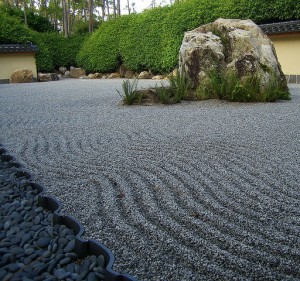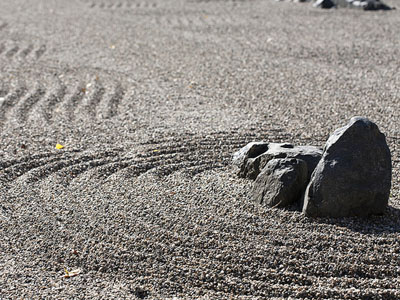Membranes for Gravel Roof Gardens
Keith Wheatley, who supplies lightweight gravel and rocks used in landscaping, has recently contacted us on twitter. Keith asked about the possibility of using his materials on rooftop gravel gardens as an alternative or addition to planting, and shared a blog post with us. He asked what membranes would be suitable for this type of Japanese gravel roof garden, so we thought we’d look into the matter and answer with a blog post too.
Lightweight Gravel on flat roofs – what to consider
There are two main issues we need to consider when looking at lightweight gravel on flat roofs.
- What is the gravel doing?
- What about the effect of the wind?
When we’ve looked at these questions, we’ll propose some alternative membranes that would be suitable for this type of roof.
Ballasting – the conventional role of gravel
In conventional single ply flat roofing, gravel is used as ballast; that is to hold the membrane down on the deck, and protect it from damage. The industry recommended minimum loading for ballasting is 50kg/m2. If you are relying on the gravel to act as ballast, then it should load the roof to at least this minimum. Of course, as with any installation on a roof you should always carry out calculations to determine whether the structure can take the weight.
If we replace conventional gravel with lightweight lava gravel, artificial rocks and boulders, these may only weigh around 30kg/m2, which may be a considerable advantage to your roof structure, but will no longer provide suitable ballast material. As a result there is potential for the roofing membrane to lift.
If you want to use lightweight gravel and rocks for your gravel garden, you therefore need to disregard them as ballast and instead may need to bond or mechanically fix the membrane to the deck.
Wind Scour – the effect of wind on ballast
The size and weight of gravel on your roof can affect its vulnerability to the wind. If lightweight, the ballast may blow about on the roof, blow off certain areas leaving them exposed, and may fall off the roof causing impact damage.
In order to ensure that wind scour will not be an issue, a wind load calculation needs to be carried out. If this indicates that that scour is a problem, the size and weight of the gravel would need to be increased, or in vulnerable areas of the roof one might instead replace the gravel with paving stones.
We have a client who has a seaside property where there is a risk of seagulls making off with ballast. If your ballast is lightweight then there may be a risk in certain locations of thievery by our avian friends! Make an assessment based on your specific location.
Before you choose lightweight gravel and rocks for your flat roof, make sure a wind load calculation is carried out and that your design will perform appropriately under the wind conditions of your site.
Which Membranes for Gravel Roof Gardens?
 Here are our recommendations for single ply membranes and waterproof suitable for use in gravel roof gardens.
Here are our recommendations for single ply membranes and waterproof suitable for use in gravel roof gardens.
We list below a range of products that are BBA Certified for use in ballasted conditions. Your choice of which product will depend on the other drivers – cost, environmental friendliness, substrate and source of manufacture. To find out more, see the ‘More Information’ section at the bottom of this post.
IKO Armourplan PVC
Armourplan is a polyester reinforced PVC membrane manufactured in Chesterfield in the UK. One of the most cost efficient membranes on the market, in this case you would choose Armourplan if you wanted to source your product from a UK manufacturer, for example.
FDT Rhenofol CG PVC
Rhenofol is also a polyester reinforced PVC membrane, but in this case manufactured by FDT in Germany. Rhenofol is also another cost competitive alternative, and also would be more suitable for a combined green and gravel roof.
IKO PermaTEC Hot Melt
PermaTEC is a waterproofing product that is applied as a hot liquid. Again suitable for ballasted roofs, it is particularly appropriate with a concrete substrate or where the roof has complex penetrations.
FDT Rhepanol fk PIB
Last but by no means least is Rhepanol fk. Also manufactured in Germany, Rhepanol is made from polyisobutylene (PIB), a synthetic rubber. It is the only membrane currently available with a full Life Cycle Assessment that meets DIN EN ISO 14040 part FF, showing that it has no significant environmental impact at any time between its manufacturer and eventual disposal. With a self-sealing edge it also has the advantage of ease of installation. If you’re concerned about sustainability, Rheponol has the best credentials on the market.
Get some Advice
Choice of membrane is not an exact science as there are many factors in play on any roof.
Alongside concerns about ballasting, wind scour and theft, you may have other particular constraints or opportunities to simplify things and reduce cost. For example, if you want to combine both green and gravel roofs, you might want to choose a membrane that is FLL certified and suits both applications as this will simplify the process of installation.
If you’d like to discuss the particular circumstances of your roof project, why not get in touch with us?
Further Information
Find out more about BRE Digest 311, ‘Wind scour of gravel ballast on roofs’.
Find out more about wind load calculations in our blog post ‘Demystifying Wind Load Calculations’.
Find out more about comparing single ply membranes with these posts about the various types:
- Comparison of Single Ply Roofing Membranes
- Choosing Single Ply Roofing Membranes – What to Consider
- When to use a Hot Melt Roofing System
Visit the pages of our website that cover:
IKO Armourplan PVC
FDT Rhenofol CG PVC
IKO PermaTEC Hot Melt
Subscribe to our blog for more posts like this one. Find out more here.
If you found this post useful, perhaps you have a question you’d like us to answer? Get in touch with us here or tweet us on Twitter. Perhaps we’ll write a blog post that will help others too.
Images of Zen Gardens: John Lodder and Alejandro Forero Cuervo (creative commons used with attribution)














Recent Comments